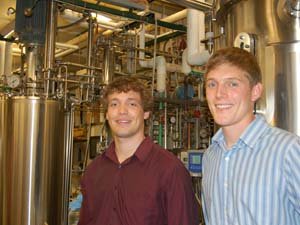Recent CSE grads launch new company based on U research

Just a little more than a year ago, two College of Science and Engineering undergraduate students were cramming for finals. Today, they are heading a start-up company designed to make drinking water safer.
For these two 2009 graduates, climbing the corporate ladder has taken a back seat to their own entrepreneurial ambitions.
Joe Mullenbach (mechanical engineering) and Alex Johansson (chemistry) founded NewWater, a company that will offer biocatalyst-based drinking water filtration technology to wastewater treatment facilities designed to reduce concentrations of a common herbicide, called atrazine, in drinking water.
Typically applied to farm fields in the spring, atrazine makes its way into water systems due to runoff during rainfalls.
Mullenbach and Johanssen recently licensed atrazine remediation technology based on more than a decade of research by University of Minnesota professor Michael Sadowsky (microbiology) and professor Lawrence Wackett (biochemistry, molecular biology and biophysics).
The connection between the two professors and the future business partners was made during a Carlson School of Management course titled “New Technology Entrepreneurship.” Sadowsky and Wackett were presenting their filtration method to Mullenbach and Johansson’s class.
Mullenbach and Johansson were immediately intrigued by the technology and decided they would want to use the filtration technique as part of an assignment for the class where they would design a business plan around the technology.
While working with Sadowsky and Wackett, the two students started to analyze the potential success of the technology outside of the classroom.
“We started to realize it was something that was exciting, innovative and had a market out there,” Johansson said.
The filtration technology behind NewWater has the potential to reduce atrazine in drinking water to acceptable levels. The technique breaks down atrazine, which is used in more than half of United States corn acreage, by using a microbe that degrades the harmful substance into non-toxic compounds.
Sadowsky said he and Wackett’s research pointed to the technique having a significant chance for success, but their love for teaching made them hesitant to create a start-up company based on it.
“We liked being professors, so we didn’t want to have to quit,” Sadowsky said.
Then came Mullenbach and Johansson, two undergraduates infatuated with the possibilities behind the technology and the drive to capitalize on them.
“We are able to take our solid technical background and incorporate that into a business,” Mullenbach said, “We hope to apply this technology for the betterment of society.”
For Wackett, he said the trust in Mullenbach and Johansson began early. “They would ask questions that were on a much more technical level. We both thought, ‘Oh, I guess these guys really can work with us,’” Wackett said.
Both Mullenbach and Johansson said their education from the College of Science and Engineering gave them confidence to succeed at anything.
“I feel like I can solve any problem that I will face because I was taught over and over again in my science and engineering classes how to identify the problem and find the solution,” Johansson said.
Johansson said they hope to have a market-ready product by 2013.
